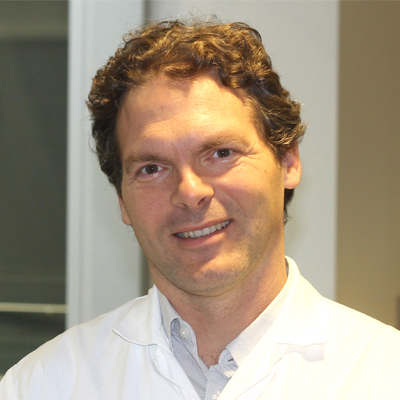Understanding Parkinson’s in its earliest stages and beyond: A Q&A with Dr. Ron Postuma
July 6, 2020

Each year during our Grand Challenges in Parkinson’s Disease symposium, Van Andel Institute presents the Jay Van Andel Award for Outstanding Contributions to Parkinson’s Disease Research to a scientist or scientists whose work is transforming our understanding of Parkinson’s. This year, we’re pleased to honor Daniela Berg, M.D., and Ron Postuma, M.D., M.Sc., for their groundbreaking efforts to identify the earliest symptoms of Parkinson’s disease and to translate their findings into new diagnostic criteria. Dr. Berg is the chair and director of the Department of Neurology at Christian-Albrechts-University in Kiel, Germany. Dr. Postuma is a professor of neurology at McGill University in Montreal, Canada.
VAI Voice caught up with Dr. Postuma to discuss what we know (and what we don’t) about the earliest stages of Parkinson’s and how this knowledge could inform future ways to diagnose and treat the disease.

Q: How has our understanding of Parkinson’s changed in the last decade, especially as it relates to the earliest stages of the disease?
RP: I think it’s really exploded. I wrote a paper awhile back on the last decade of prodromal Parkinson’s where we pointed out that we had maybe two or three proven predictors of Parkinson’s about 10 years ago. Now, we have about 30. We’re really getting very good at understanding how to identify the early stages of Parkinson’s, and we can do it relatively reliably.
Q: How does an improved understanding of prodromal Parkinson’s impact development of potential diagnostic methods/criteria and therapies? Could it possibly inform preventative measures in the future?
RP: There are two big problems when it comes to developing neuroprotective therapies.
The first is that, by the time someone is diagnosed with Parkinson’s, it might be too late to save certain areas of the brain. At that point, they’ve probably had disease pathology in their brain for an average of 10 years. Our systems are pretty good at being redundant, meaning you can lose some brain cells without noticing because we have backups that can compensate. That means that by the time a person is actually diagnosed with Parkinson’s, the disease is already quite advanced and has claimed enough brain cells to override the body’s redundancies. So by the time they notice symptoms, it’s too late to use preventative methods because the damage is already done.
The second thing is that it’s really hard to test what we call neuroprotective therapies in Parkinson’s disease. For example, say you want to test a neuroprotective therapy and, as a metric, you want to look at the way a person walks. You start the protective therapy, but then also give them a medication that dramatically improves the way that they walk for three or four years. The second therapy masks the sign that you’re trying to measure, and you can’t tell if you’re actually slowing down disease progression.
Doing a trial in prodromal Parkinson’s fixes these two problems: 1. you’re doing the trial much earlier in the disease, when you have a greater chance to intervene, and 2. the patient isn’t being treated with anything that could mask symptoms (because the motor symptoms aren’t present yet). This allows you to actually see the real changes.
Q: What is the most important thing for people reading this to know about the earliest stages of Parkinson’s?
RP: Most of the predictors of Parkinson’s that we know of aren’t motor — that is, movement related. Instead, they’re things like loss of sense of smell, constipation, acting out your dreams at night and drops in blood pressure when you stand up. Those are, in fact, among the best predictors of Parkinson’s disease. Although we largely associate Parkinson’s with motor problems, it’s the non-motor things that are really important in the early diagnosis because they are present in the earliest stages of disease, before motor symptoms.
For example, take REM sleep behavior disorder, a condition in which you act out your dreams at night. Some 80% of people who have that disorder are eventually diagnosed with Parkinson’s. It’s basically a diagnostic test by itself.
Q: What are some of the critical gaps in knowledge when it comes to prodromal Parkinson’s?
RP: We still have a needle-in-a-haystack problem, in that maybe 1% of the population past the age of 60 or so has prodromal Parkinson’s disease. It’s very hard to find people with prodromal disease because we need very good, very strong markers to be able to identify Parkinson’s early on in the disease (although once we are able to make the diagnosis, it’s pretty reliable). We still don’t have a reliable test to pick up a majority of people in the early stages.
Q: Where do you see Parkinson’s research going in the next five years?
RP: The thing I hope will happen in the next five years — and I’ll be bitterly disappointed if it doesn’t — is that neuroprotective treatments that are being tried in later stage Parkinson’s disease (when they’re less likely to work) will be tried in prodromal Parkinson’s, where they’re more likely to work. I think there is a trend toward that happening.
Once that happens, the dam will open, and we’ll really start to think of prodromal Parkinson’s not as some precursor stage to Parkinson’s disease, but as true Parkinson’s, just in its early stage.
I think we’re going to see more prodromal research, and we’re going to see those trials come — someone’s going to take the chance. And if it’s a good drug, maybe it will be the first drug to ever prevent Parkinson’s disease.
Grand Challenges in Parkinson’s Disease and Rallying to the Challenge are going virtual for 2020! Learn more at grandchallengesinpd.org.